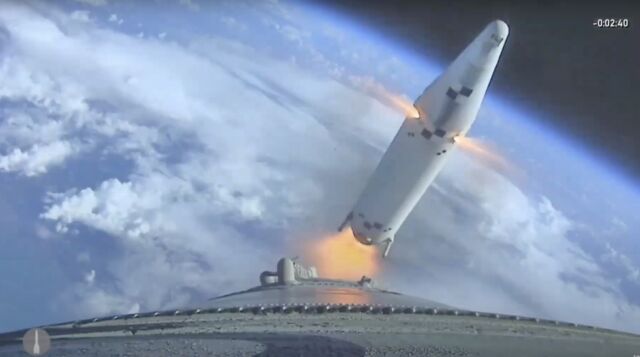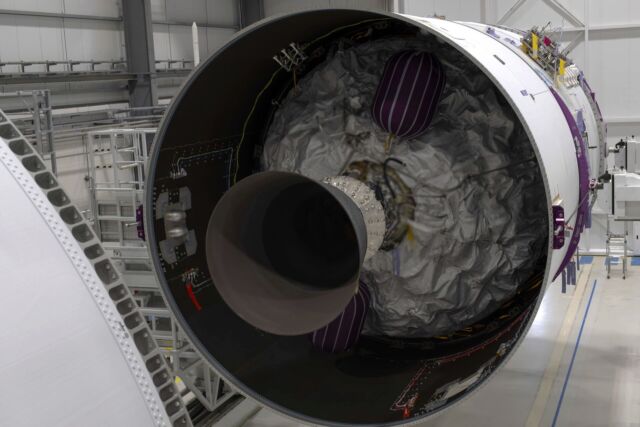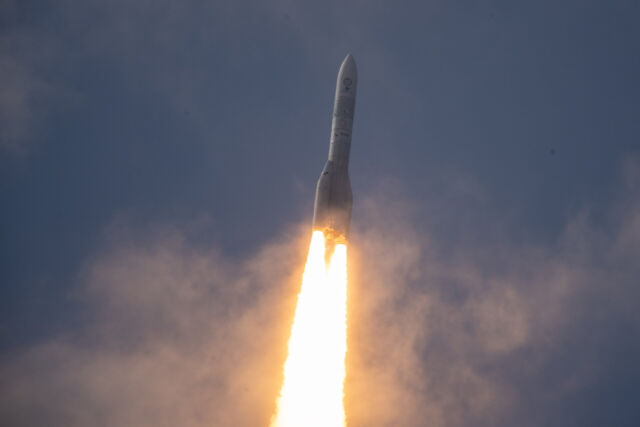Europe’s first Ariane 6 flight achieved most of its goals, but ended prematurely

The first European Ariane 6 rocket fired off its launch pad at the edge of the Amazon rainforest and climbed into orbit Tuesday, an inaugural flight a decade in the making that restored Europe’s ability to put its own large satellites into space.
The debut of the Ariane 6 rocket came almost exactly one year after Europe’s previous workhorse rocket, the Ariane 5, flew for the final time. Running four years late, the Ariane 6 is set to become Europe’s next flagship launcher. But delays in its development, combined with other factors, forced European governments to pay SpaceX to deliver several payloads to orbit.
With Tuesday’s test flight, European space officials hope those days are behind them. The European Space Agency paid more than $4 billion to get the Ariane 6 rocket to this point, with the goal of replacing the Ariane 5 with a cheaper, more capable launcher. There are still pressing questions about Ariane 6’s cost per launch, and whether the rocket will ever be able to meet its price target and compete with SpaceX and other companies on the commercial market.
As Ariane 6 transitions to commercial operations, ESA member stages have agreed to continue propping up the program with hundreds of millions of dollars in government subsidies per year. The Ariane 6 rocket is expendable, and is one of only a few launchers of its size worldwide without at least a roadmap to evolve into a partially reusable vehicle.
But for ESA, with a core policy of ensuring European satellites can ride to space on European rockets, getting Ariane 6 to the finish line is reason to celebrate.
“Europe is back,” said Josef Aschbacher, ESA’s director general. “This powers Europe back into space.”
Successful liftoff
The first Ariane 6 launcher lifted off from the European-run Guiana Space Center in Kourou, French Guiana, at 3 pm EDT (19:00 UTC), an hour later than originally planned after preparations fell behind schedule earlier in the day.
The countdown clock smoothly ticked through the final moments before liftoff without any major issues, and the Ariane 6 lit its hydrogen-fueled Vulcain 2.1 main engine, followed seven seconds later by ignition of two strap-on solid-fueled boosters to propel the 183-foot-tall (56-meter) launcher off the pad.
Then, Ariane 6 was off to the races, riding 1.9 million pounds (8,400 kilonewtons) of thrust through a late afternoon sky. The launcher rolled onto a course northeast from the tropical spaceport in South America, soaring over the Atlantic Ocean before shedding its two spent booster casings a little more than two minutes after liftoff. A minute later, the Swiss-made payload fairing jettisoned from the top of the rocket.

European Space Agency
Then, just shy of the eight-minute mark, the Vulcain 2.1 engine shut down and the rocket’s main stage fell away to make way for the upper stage’s Vinci engine to finish the job of accelerating to orbital velocity. The Vinci engine, burning the same mix of liquid hydrogen and liquid oxygen as the main stage, fired until around 18-and-a-half minutes into the flight to reach a preliminary transfer orbit.
The upper stage coasted halfway around the world before briefly reigniting the Vinci engine to circularize its orbit at an altitude roughly 360 miles (580 kilometers) and an inclination of 62 degrees to the equator. A few minutes later, the rocket deployed nine small CubeSats for US and European research institutions, including a pair of small NASA-funded spacecraft to study radio waves emitted from the Sun.
Up until this point, the Ariane 6 rocket’s first flight appeared to go perfectly. The lower portion of the Ariane 6 is powered by a Vulcain engine derived from the main engine that flew on the Ariane 5 rocket, and strap-on boosters based on propulsion technology developed for Europe’s smaller Vega C rocket.
”Today, Ariane is back!” said Martin Sion, CEO of ArianeGroup, prime contractor for the Ariane 6 rocket. “And today, with this new launcher, Europe is restoring its autonomous access to space.”
Mission incomplete
But a short time after Sion’s remarks, a malfunction on the upper stage prevented the Vinci engine from completing a third burn to steer back into Earth’s atmosphere for a targeted, destructive reentry.
The upper stage is the most significant new element on Ariane 6. Its Vinci engine has been in development since 1998, initially to fly on an upgraded version of the Ariane 5, and then repurposed for the Ariane 6 program. The cryogenic engine, which finally reached space for the first time Tuesday, produces about 40,000 pounds (180 kilonewtons) of thrust, and is capable of igniting up to four times on a single launch.
The restartable Vinci engine will allow Ariane 6 to deploy payloads at different altitudes, or inject satellites directly into high-energy geosynchronous orbits, like SpaceX’s Falcon launchers or United Launch Alliance’s Atlas V and Vulcan rockets. The upper stage also has an Auxiliary Propulsion Unit (APU)—essentially a miniature second engine—to fulfill several important functions.
These include drawing small amounts of liquid hydrogen and liquid oxygen from the upper stage propellant tanks, heating it up with a 3D-printed gas generator, then injecting the gas back into the tanks to pressurize them. The APU also produces a low level of thrust, enough to settle floating propellant in the upper-stage tanks before each ignition of the Vinci engine, or to make fine adjustments to the rocket’s position in space to release payloads in slightly different orbits.
This is a useful feature for missions like the 18 launches Amazon has booked on the Ariane 6 rocket to deploy satellites for the Project Kuiper internet network. Most rockets use helium to pressurize their propellant tanks, but designers introduced the APU on Ariane 6 to reduce weight and to take advantage added benefit of the APU as a low-thrust secondary engine.

The APU functioned normally in the first phase of the Ariane 6 mission, and it was supposed to power up again as the upper stage coasted through space between its second and third engine burns.
“At one point in time, we reignited the APU,” Sion said in a post-launch press conference. “It did reignite, and then it stopped. We don’t know why it stopped. This is something that we will have to understand when we’ve got all the data.”
The APU malfunction had several consequences for the remainder of the test flight. The Vinci engine was unable to restart because the APU wasn’t operating to properly condition the rocket’s propellant tanks. This third Vinci burn, slated to happen more than two-and-a-half hours into the mission, was supposed to slow the rocket’s velocity enough for it to drop out of orbit and reenter the atmosphere, where it was expected to break apart over the Pacific Ocean.
Instead, the upper stage will remain in low-Earth orbit, likely for decades, until wispy atmospheric drag naturally pulls it back toward reentry. Sion said the upper stage was “passivated” to reduce the risk of an explosion that could generate more space junk. Passivation usually involves emptying the propellant tanks and draining batteries.
After its final burn, the upper stage was programmed to release two commercially-developed beachball-size reentry capsules to fall back into the atmosphere. These capsules, owned by ArianeGroup and a European startup named The Exploration Company, were designed to gather data on reentry and test the performance of their heat shields.
The Ariane 6 upper stage autonomously canceled the command to deploy the two return craft. The capsules would not have been able to complete their missions because they relied on the Vinci engine to guide them to their reentry targets.
“So we had an event which is not understood yet, which is why did the APU stop?” Sion said. “But all the rest of the mission was according to plan. This is unfortunate, but this is also why we make a tech demo in flight because there are some things we cannot test on the ground.”

The final phase of the Ariane 6 test flight, when the APU anomaly occurred, was intended to demonstrate the performance of the upper stage during a long-duration coast. Engineers wanted to gather data on the APU, the Vinci engine, and the condition of propellants within the upper stage’s tanks. The rocket’s liquid hydrogen and liquid oxygen must be kept at cryogenic temperatures for the engine to work.
“There were several phases in this flight,” Sion said. The first two phases involved liftoff and the deployment of Ariane 6’s first nine payloads into orbit.
“Then we had a demonstration phase, which was to see how the upper stage behaves in microgravity, and how all the different systems operate because microgravity is something we cannot test on the ground,” Sion said.
On the clock
Despite the malfunction late in the Ariane 6 test flight, officials said after Tuesday’s launch that they will proceed with the first operational Ariane 6 mission before the end of the year. This flight will launch a French military spy satellite named CSO-3.
Stéphane Israël, CEO of the French launch services company Arianespace, said the APU problem has “no consequence” for the next Ariane 6 flight. France’s CSO-3 satellite will launch into a low-altitude orbit. Because it’s going to a low orbit with a single satellite, this mission presumably won’t require the Ariane 6 upper stage to ignite its APU several times as it tried to do Tuesday.
“What we have achieved tonight with the launch success enables us to prepare the next missions,” Israël said.
Arianespace will take over responsibility for Ariane 6 launch operations with the next flight, just as it did for Ariane 5 rocket before. ESA was in charge of the Ariane 6 demonstration flight. Arianespace has a backlog of 29 Ariane 6 flights, with reservations from European government customers, Amazon Kuiper, Intelsat, Eutelsat, and the Australian telecom company Optus.
After potentially two launches this year, Arianespace aims for six Ariane 6 flights in 2025, eight in 2026, and 10 in 2027. “What has been achieved tonight allows to go full speed with this ramp-up,” Israël said.
Sion was a bit more circumspect in his comments, saying that the capabilities Ariane 6 demonstrated with Tuesday’s flight cover what is required for the “largest part” of the rocket’s planned missions. Some of Ariane 6’s future launches, like those with Europe’s Galileo navigation satellites or Amazon’s Kuiper spacecraft, will use some of the upper stage’s long-duration capabilities ESA tested Tuesday.
“When you’ve got something that you don’t understand, you have to understand to see if it will have consequences,” Sion said. “But when we make a flight like the one we did today, what is important is to have clear objectives and to say, ‘OK, if we have made this, and this, and this, we are where we should be in order to authorize the next launches. And all that has been fulfilled.
“So it’s true that in the next days and weeks, when we have all the data, we will analyze to understand better what happened,” Sion said. “What is clear is that the APU, when we restart it in microgravity … we knew that the way it would behave would be different. But a lot of missions do not need to be restarted in microgravity. This is a flexibility that we could use or not.”
Nevertheless, the Ariane 6 achieved most of its objectives Tuesday. The Vulcain main engine and solid-fuel boosters worked. The Vinci engine worked. So did the brand new launch pad for Ariane 6. The rocket’s guidance system appeared to function normally, something that ESA officials couldn’t say after the Ariane 5 rocket’s disastrous first flight in 1996, which ended in an explosion.
“We are relieved. We are excited,” Aschbacher said in a post-launch press conference. “This is a historic moment. An inaugural launch of a heavy launcher does not happen every year. It happens probably every 20 years, or every 30 years. The last one (for Europe) was about 30 years ago, and today we have launched Ariane 6 successfully, and this is a big milestone.”
Sion agreed, adding that he felt a “sense of relief” after Tuesday’s flight.
“But also a sense of pride for all the teams who have been working for this program, the thousands of rocket-makers from ArianeGroup, from all the European industrial partners, from 13 countries, who have been working tirelessly on this program to overcome these challenges. It has been a difficult program, and their work enables us today to see such a brilliant success.”
Source link




